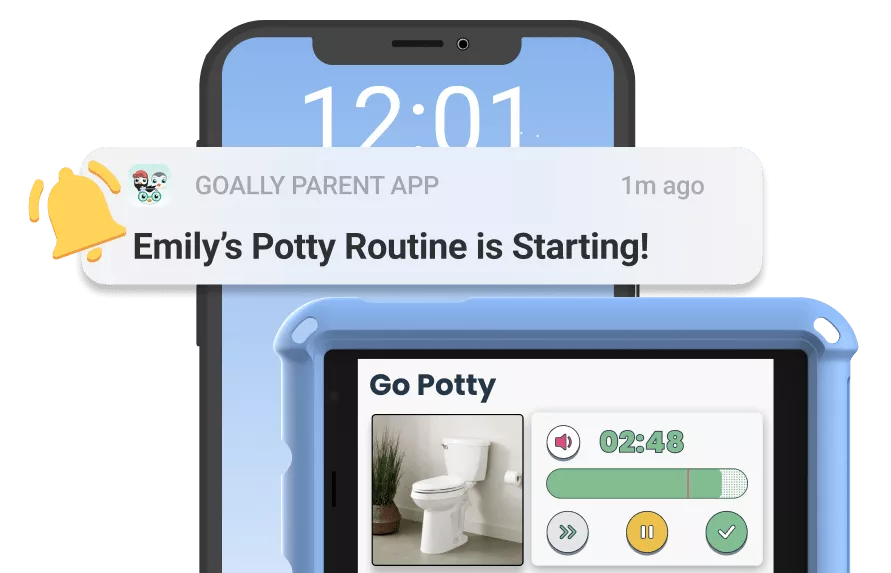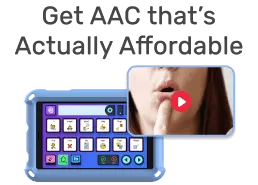Imagine walking into a busy new restaurant for the first time. There are multiple lines, there’s no one at the hosting station, and some people have taken a number from somewhere. Do you line up, find and take a number, wait for a hostess, or walk out the door? For our Autistic and neurodiverse children, completing ordinary tasks can feel like walking into that restaurant! They don’t know where to begin a task, or what will happen next. That’s why so many parents, teachers, and providers use First-Then schedules.
Table of Contents
“First, Then” visual schedules are life-changing tools that can help children of all ability levels work toward independence. You can use it as a daily schedule or as part of a behavior management plan. In both cases, they are simple but exceptional learning tools for neurodivergent learners.
If you’re curious about how a first then schedule can make life easier for you and your child, then keep reading! Discover how parents and teachers who use Goally implement these effective visual aids both in the classroom and at home.
What Are First-Then Schedules?
| First | Then |
|---|---|
| Brush Teeth | Watch TV |
| Math Lesson | Computer Time |
In essence, a “First, then” schedule is a simple visual schedule featuring two boxes or columns. The left column is labeled “first” and the right column is labeled “then.” It helps children understand the order of tasks and what comes next.
Parents and educators can use a “first, then” schedule in two ways:
- Break down tasks as part of a daily routine.
- Use it as part of a behavior modification system.
For example, a schedule can be used to help a child prepare for a non-preferred activity by displaying it in the “first” column, followed by a preferred activity in the “then” column. This helps the child know that if they complete the non-preferred task, they will get to enjoy the preferred activity.
Goally | The Safest Tablet for Kids

A “First, then” chart is a simple but effective tool that provides structure and promotes understanding for children. By using visual cues and rewards, it helps children stay organized and motivated throughout their daily routines.
Choosing the Right “First”
When choosing the activity to place in the “first column,” be sure the activity is small and has an end in sight. Your child should know when they have completed the task. If it’s confusing or open-ended, they may become frustrated, making the tool less effective.

Read More: How to Make Daily Schedule for Kids at Home That They’ll Actually Follow
It’s super important to pick the right task for your kid when you’re trying to use token board templates. You want to make sure that it’s something they can actually handle, otherwise, it might just lead to frustration on both sides. Sometimes this means breaking down a bigger task into smaller, simpler steps. For instance, instead of asking a child with ADHD to “tie your shoes,” it might be more effective to start with “put on your shoes.” That way, they can start building confidence and success with smaller tasks before moving onto more challenging ones.
Choosing the Right “Then”
A “first, then” schedule is effective because it uses the Premack Principle. That means that your “then” activity must be motivating enough to encourage your child to get through that tricky “first” activity. If the “then” activity isn’t a preferred task, you’re less likely to see much progress!
To choose a great “then” task, consider what you know about your child. What rewards or preferred routines motivate them? Some children need that “then” column to say “screen time,” while others do just fine when offered a snack or trip to the park. Your “then” task can be simple as long as it’s motivating for your specific child! In some cases, you can even offer more than one choice in the “then” column and allow your child to decide. You know your child best—if the choice is motivating, use it!
Printable & Customizable First-Then Visual Schedules for Kids
We’re offering a free printable first-then visual schedule for you to use with your child! Making this printable work for you will require a little bit of DIY flair. Simply download and print out the schedule template and then follow the steps below.
- First, laminate the two-columned “First, Then” chart or place it in a translucent plastic pouch, such as a sheet protector.
- Next, use the blank grid boxes on the sheet labeled “Task Cards” to illustrate the tasks that you will be focusing on. If you aren’t artistic, you can print out clipart or use magazine cutouts instead! Be sure to label each task clearly. We’ve included a few pre-illustrated task cards to get you started!
- If you will be using the task cards, cut out each card, laminate, and trim.
- Affix velcro squares or dots to the first-then chart and on the back of each laminated task card. If you don’t have velcro, you can use tape or blue tack instead.
- Store any unused images in a small sandwich bag. Feel free to add new task cards as your child’s schedule and preferences change.
Read More: Best Weather App
Goally | Apps To Structure Your Kiddo’s Routine
Does your child struggle with transitions or staying on task? Goally’s visual schedule app breaks down large tasks into small, achievable steps. It helps kids complete their tasks independently!
Wrap It Up
In conclusion, we have explored the concept of a “First Then” chart and its benefits for individuals with autism. A First Then chart is a visual tool that helps individuals understand and follow a sequence of tasks or activities. By breaking down tasks into clear steps and providing a visual representation of what needs to be done first and what comes next, the First Then chart can help individuals with autism better comprehend and navigate their daily routines. This visual support promotes a sense of predictability, reduces anxiety, and enhances communication and understanding. It allows individuals to see their progress and offers a tangible way to track and reinforce positive behaviors. The flexibility and adaptability of First Then charts make them effective tools for teachers, parents, and caregivers to create structured environments that promote independence and success. Overall, the First Then chart is a valuable resource that promotes organization, communication, and self-regulation for individuals with autism, helping them thrive in their daily lives.
FAQ’s About First Then Chart
What is a first then chart? A first then chart is a visual tool that helps children understand what activity they need to complete first before moving on to the next one. How does a first then chart help children? First then charts help children by providing a clear sequence of activities, reducing anxiety and improving focus. Can a first then chart be used for children with special needs? Absolutely, first then charts are especially beneficial for children with special needs, including those with ADHD or autism. How do I create a first then chart? Creating a first then chart involves listing the tasks in the order they need to be completed, using simple language and visual cues. Can a first then chart be used with rewards? Yes, you can incorporate rewards into your first then chart to motivate your child and reinforce positive behavior.
This post was originally published on 09/07/2022. It was updated on 02/02/2024.

Goally
We help parents teach their kids life skills, like doing bedtime and morning independently. Backed by science, we incorporate evidence-based practices and expert-informed designs in all of our apps and content.




